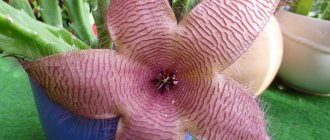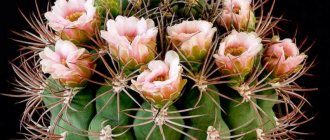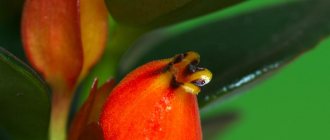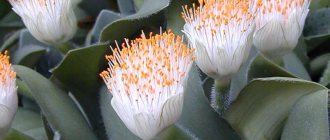What does a Gymnocalycium cactus look like?
The plant belongs to the Cactus family. From Latin the name Gymnocalicium is translated as “bare calyx”. The flowers are not covered with hairs, but are covered with smooth scales. The height of the trunk can vary from 1.5 to 7 cm. The diameter can be 2.5-15 cm. The shape of the above-ground part is round or flat. Flowers can have different shades.
Appearance
There are more than 150 species of Gymnocalycium that share the same botanical description. This is a perennial plant with dense roots that go deep into the ground. The aerial part is dark green in color, and the skin itself is smooth to the touch.
Additional Information! Varieties have been selectively bred whose shoots can be yellow, red or orange.
The most common types of Gymnocalycium:
- Reductum;
- Friedrich or Japanese;
- Baldianum or Balda;
- Mikhanovich;
- Horst.
Appearance of one of the varieties
There is also a separate group of the species, which is formed from several plants similar in shape and size.
Reproduction by seeds and shoots
Seeds
Gymnocalicium flowers do not self-pollinate. Two unrelated hymnocalicium (preferably different subspecies) are required for successful pollination and seed production.
Conditions for seed propagation:
- Germination varies from 2-5 days to one month, since some species have large seeds with a durable shell.
- An important condition for good seed germination is temperature. The optimal range for most species is the temperature range of +23-25 °C.
- Extreme temperatures - below +12 °C and above +28 °C - do not promote germination.
For most species, the highest germination percentage is at a constant temperature of +25 °C. The best time for sowing is the third ten days of February.
Step by step planting seeds:
- Planted in moist soil, covered with film.
- Be sure to open the soil for 10 minutes a day and remove excess moisture from the film. Watering should be done once every 4-5 days.
- The seedlings will hatch in 3-2 weeks. You can plant them after the thorns appear.
Sowing
Materials and tools:
- A technical or any other container with a drainage hole, a neck diameter of about 10 cm and a height of 3 to 7 cm.
- Plastic bag.
- Soil mixture: 1 part vermiculite + 1 part charcoal + 2 parts leaf humus. The mixture must be sterilized.
- Fill the container with soil mixture. The distance from the soil surface to the edge of the container must be at least 15 mm.
- Sow the seeds evenly on the surface of the soil. The seeds are not sprinkled with soil, but pressed with the pads of the fingers. Place a plastic bag in the pot.
Lighting – bright diffused light . Frequency of watering - light drying of clay soil (slightly dry - water). Water the plant by spraying from a spray bottle. As soon as the cactus reaches a diameter of 1.5 - 2 cm, it is transplanted into a separate small container (100 ml).
By shoots
Gymnocalycium can reproduce by seeds and vegetatively using layers, also called children.
Reproduction by shoots step by step:
- The shoots are carefully separated from the mother succulent plant.
- Place in a separate container with water. Roots form quickly.
- After this, carry out the adjustment in moistened soil.
For the colored hymnocalicium, this is the only method of reproduction. The cutting time is early spring.
Common varieties
How to plant a cactus: examples at home
This type of cactus is widespread in floriculture. Therefore, many varieties have been selected for decorative cultivation, among which are the most popular:
- Gymnocalycium Reductum (humpbacked) is the largest representative of the species. As it grows, the shape and color of the stem changes. The plant grows from a ball into an oval, which is divided by furrows. Reductum can grow up to half a meter. The spines are arranged radially. At the top of each segment there is a bunch with sharp long spines.
- Gymnocalycium Friedrich (Albiflorum). The succulent was obtained thanks to the efforts of Japanese breeders and therefore has a second name: Japanese gymnocalycium. After the chlorophyll was removed, the plant stem began to change color - purple, burgundy, red, yellow. The appearance attracts with its originality. But the hybrid cannot grow on its own; it must be grafted onto another cactus.
- Gymnocalycium baldianum - in Russia it is most often called Gymnocalycium Balda. It has the shape of a flattened ball of blue-green color. The height of the trunk reaches 10 cm and the width is 9 cm. Gymnocalycium Baldianum is covered with grooves, which turn into “tubercles” as they grow. At the top of each segment there are needles. Depending on the prefix, the color of the buds is determined - Kla, Yellow.
- Gymnocalycium Horst reaches a height of 20 cm. The stem has the shape of a flattened ball of dark green color. At the moment of flowering, you can see a bud of pink, lilac or cream color.
- Gymnocalycium mihanovichii has a 5 cm tall stem with comb-like projections. Along the crests there are waves that visually change the shape of the above-ground part. At the top of the ridges there are light spines, located only radially. The flower is pink-green, sometimes with white-green buds.
Friedrich's appearance
- Aqua Dulce is a miniature version of Gymnocalycium, which is distinguished by a low, powerful stem. Rare spines are found on the surface of the aboveground part.
- Gymnocalycium denudatum is a miniature species. The stem height does not exceed 30 mm in height, and the diameter is 80 mm. The shape of the aerial part is a ball, which is slightly flattened on top. At the time of flowering, it produces several small white buds.
- Damsi is classified as a succulent due to its small size (height 20 mm, diameter 50 mm). It has a round trunk of light green color with radially arranged needles along.
- Gymnocalycium ragonesii is a small cactus with a brown-green trunk. On the surface of the above-ground part, Ragonese has not very clear grooves, which are radially covered with spines.
- Gymnocalycium quehlianum (Quelya) is a succulent no more than 10 cm high. The color of the above-ground part is bluish-green. When flowering, the bud is colored red with a more expressive edging of the same color.
- Gymnocalycium spegazzinii has a barrel-shaped aerial part that is gray-green in color. The trunk is divided into ribs with areoles. They have curved spines 5-7 mm long.
Note! The “montain” label identifies the cactus as a frost-resistant plant. The maximum temperature drop can be +5 °C.
Appearance of Ruductum
Gymnocalycium mix cactus is a group of several small varieties. The diameter of the trunks does not exceed 50 mm. “Mix” is usually planted in one container, creating a combination of plants of different colors and different shapes.
3.Varieties:
3.1. Gymnocalycium mihanovichii
Spherical cacti whose stems can take on a cylindrical shape with age. The ribs are deep, widely spaced, and have thin transverse projections. Stems are burgundy, brownish, dark green. Even adult plants remain miniature and often do not exceed 5 - 6 cm in height. At the tops of the ribs there are areoles with short, thick, strong, straight spines. During the flowering period, bright funnel-shaped flowers with long floral tubes and many thin, long petals in white, yellow, pink or cream shades appear near the tops of the stems.
Gymnocalycium Michanovich has numerous variegated varieties, the stems of which are bright shades of yellow and red - such plants can often be seen in flower shops grafted onto Hylocereus.
↑ Up,
3.2. Gymnocalycium baldianum
Spherical or slightly flattened cacti with matte, green stems up to 15 cm high. As plants age, they often form lateral shoots at the base of the stems. The ribs are wide, indistinct, often have rounded high tubercles with areoles, in which thick, slightly curved, strong light spines are collected. The flowers appear at the tops of the stems, reach 3 - 4 cm in diameter, pink, red, lilac.
↑ Up,
3.3. Gymnocalycium saglionis
Globular cacti with matte green stems. With age, plants can reach a height of 90 cm, while the stems will retain their rounded shape. The ribs are shallow, closely spaced, with wavy spaces formed by numerous low, rounded tubercles. The spines are long, curved, light silvery, brown, orange or reddish, reaching a length of 3 - 4 cm. The flowers are funnel-shaped, pink or white, with short and wide petals. During the flowering period, the buds form a flower wreath on the stems of cacti.
↑ Up,
3.4.Naked Gymnocalycium - Gymnocalycium denudatum
Low, spherical or flattened cacti with glossy, green stems. With age, the stems can reach a height of 10 - 15 cm. The ribs are wide, shallow, rounded. The areoles are sparse, covered with small short fluff. The spines are light - white, gray or yellow, long, curved, reaching 1 - 1.5 cm in length. The flowers are white or pink, on long flower tubes, funnel-shaped, reaching a diameter of 7 cm.
↑ Up,
3.5.Gymnocalycium schroederianum
Solitary growing cacti with flattened green stems up to 15 cm high, covered with fuzzy ribs. The ribs are indistinct. Conical high tubercles are formed on the stem, at the tops of which areoles with light, straight, strong, short spines are located. During the flowering period, large buds appear on the tops of the shoots on long flower tubes, opening into funnel-shaped attractive cream or yellow flowers up to 6 cm in diameter.
↑ Up,
3.6.Gymnocalycium Andreae
Miniature spherical cacti up to 5 cm high, which with age can form a large colony. The stems are bluish-green, with wide and shallow vertical ribs. The areoles bear several light, straight spines, reaching a length of 1 - 1.5 cm. The flowers are funnel-shaped, yellow, cream, pink, up to 6 cm in diameter, and can completely hide the stems of the plant.
↑ Up,
Features of home care
Astrophytum cactus: options for different types and examples of care at home
If we talk about this variety of cacti, including the Gymnocalycium mix variant, caring for them at home is not too difficult. Agricultural technology involves control over the main indicators - watering, temperature, humidity and light. If you properly care for a group of plants, then within the allotted time frame you can observe flowering, and the trunk itself will increase in size.
Temperature
The flower is not picky about temperature conditions, but its homeland is South America, which means it should still be warm. At different times of the year, succulents are grown at different temperatures:
- In summer, any temperature is suitable.
- In winter - +8-12 degrees Celsius, some require a temperature of +15-18 °C.
- The Mikhanovich cactus can grow at +5 °C in winter.
If the air temperature is too low, the plant will die.
Lighting
The plant needs good lighting. The stem should not be exposed to direct sunlight, otherwise burns in the form of brown spots will appear on the skin. The room should be well ventilated.
Cactus outdoors
Important! Flowerpots with plants should be placed on window sills on the south side to improve lighting at any time of the year.
If direct sunlight comes through the window, you need to artificially disperse them or remove the flowerpot for several hours in a more suitable place.
Watering
Watering is done approximately 2-3 times a month. You need to keep the soil dry. Only settled water at room temperature can be used in the irrigation process.
Implementation of watering
During the flowering period, the amount of watering may increase.
Attention! Once a month, you can add a drop of lemon juice to the watering liquid.
Spraying
Do not spray the stem of a cactus under any circumstances. Water entering the above-ground part can lead to rotting. The exceptions are those “baths” that involve treatment.
Humidity
There is no need to control air humidity in the summer, but it should not be 100%.
In winter, the figure should not exceed 70%. Otherwise, the plant will begin to rot. To maintain normal humidity in the room, you can use special devices.
Priming
Soil for cactus is a mixture of humus, turf soil, peat, and sand. All components are taken in equal quantities.
The right substrate
Attention! To improve the quality of the substrate, you can add a little charcoal.
Feeding
Fertilizing is done once a month during the growing season. In winter and autumn, the application of any fertilizers is prohibited. Mineral fertilizers that do not contain organic components are used as fertilizing. Supplements should contain some nitrogen.
Growing at home: basic requirements
In order for the plant to maintain abundant flowering for many years, it is important to take into account all the nuances of care. It is unpretentious and survives even in difficult conditions, but to maintain external aesthetics, you need to take into account a number of factors depending on the season.
Table: basic conditions of detention
| Important Factors | Autumn winter | Spring Summer |
| Lighting | Cacti need a lot of light, so in the dark season you need to provide additional lighting in the form of a fluorescent lamp | To avoid burns, the plant should be kept away from direct sunlight, especially at midday. Alternatively, use fabric shade or place the pot under broadleaf plants that can provide natural shade. |
| Humidity | Gymnocalyciums are unpretentious to air humidity, so they do not require additional spraying | In summer, they can easily tolerate increased dry air; this is their natural environment. |
| Temperature | The temperature should be reduced to 15–18°C, with a minimum of 5°C | Permissible temperature 20–24°С |
Planting and transplanting
Gymnocalycium has a low growth rate, so it does not need frequent replanting. It is recommended to do this no more than once every 2-3 years. Very young plants are replanted every year, but once they reach two years of age, the growth rate slows down.
The pot for replanting the plant is selected by comparison. It should be 4–6 cm deeper and wider than the previous one. The transplant process is as follows:
- The rhizome is cleaned of dead particles and soil, then washed in warm water.
- The washed roots should be left to dry for 2 days.
- After the drying time has passed, the plant is placed in a new pot. The soil should consist of turf and leaf soil, coarse sand and peat in equal proportions.
- Watering is done with acidified water.
Features of watering and fertilizing
The amount of watering depends on the time of year. But it is also important to ensure that the soil is not over-watered. Regardless of the schedule and time of year, you should not add water to the plant if the top layer of soil has not yet dried. At the beginning of autumn, watering should be reduced gradually, and in the middle reduced to a minimum.
Fertilizers are applied only in summer and spring, every 2–3 weeks. For these purposes, specialized cactus fertilizers are used. They must contain organic substances and mineral supplements. No fertilizing is needed in winter and autumn.
Recent Entries
Chainsaw or electric saw - what to choose for the garden? 4 mistakes when growing tomatoes in pots that almost all housewives make Secrets of growing seedlings from the Japanese, who are very sensitive to the soil
Formation of a chlorophyll-free plant
Non-chlorophyll forms of the plant can be identified by the shade of the flowers: they are yellow, red and lilac-orange. In order for them to grow, they must be vaccinated. This necessity is due to their inability to photosynthesize. The rootstocks are Hylocereus triquetrum, Trichocereus and Eriocereus.
A brown or green stem indicates that the plant itself is capable of providing itself with chlorophyll. Such cacti do not need to be grafted. However, if such a plant is in serious condition, for example, rotting, grafting will save its life.
Step-by-step instructions for vaccination:
- A healthy donor plant is selected for grafting.
- All equipment is disinfected.
- Sharp cuts are made on the rootstock and scion.
- Immediately after making the cut, the particles are attached to each other and secured with a bandage.
The bandage should not be too tight. The plant should remain in this position for at least a week, and then the bandage is removed.
Flowering and dormant period
Gymnocalyciums bloom from the age of 2 years. Rare varieties have a long period of maturation and their first flowering time can occur at 5–6 years. Proper care allows the plant to produce flowers annually. The first buds appear in April, and the flowering period begins in May.
Due to lack of sunlight, not all buds are able to bloom. In order for the flowering period to continue throughout the summer and autumn, it is important to keep the flower pot close to the window. Open flowers do not last long, from 7 to 10 days.
Gymnocalyciums rest in winter. At this time, they gain strength for the next flowering period. Therefore, you cannot water them throughout the winter months. It is also undesirable to frequently move plants and transfer them to different places. During the rest period, sudden changes in temperature should not be allowed.
Solving common growing problems
If spots appear on the cactus, it is important to examine them carefully. Darkening at the base indicates overwatering. In this case, the spots are an external manifestation of rotting of the rhizome. If the stain is due to rot, it will have a soft and moist texture. A dry and hard but darkened base of the stem is not a disease, it is a manifestation of the natural suberization process.
Small spots located around the areola indicate mechanical damage. Also, such darkening often appears due to fungal infections or sunburn. In this case, it is necessary to carefully monitor their formation for a week. Growing spots need to be treated with an antifungal drug.
If the cactus does not bloom, you should reconsider the process of organizing the dormant period. This phenomenon indicates that the gymnocalycium was unable to accumulate strength and rest. To satisfy its needs, it is important to provide the plant with cool and dry conditions during the cold season.
Dropping buds is a reaction to a sudden change in temperature, location or lack of light. To correct the situation, just change the location of the pot, increase watering and monitor the temperature in the room. After the first flower stalk appears, it is recommended to increase the amount of light and add fertilizer to the soil.
Diseases and pests
Although the plant is very unpretentious, even it is susceptible to a number of diseases. They are associated only with disruptions in care. When handled correctly, Gymnocalycium adapts to any conditions and is resistant to pests.
Dangerous care violations:
- use of water with high hardness;
- alkaline soil;
- damage to the rod during layering propagation.
The main pests of flowers are scale insects and flat mites. The second is evidenced by rusty spots on the surface of the plant. Since the insect is very small, it is often difficult to notice in the initial stages of establishment. Young plants under 2 years old are most susceptible to mites.
To get rid of the mite, just rinse the cactus stems with hot water and then lubricate them with ethyl alcohol. It is recommended to use pesticides only as a last resort if the disease has affected an entire collection of cacti at once.
Example of Mealybug Manifestation
Mealybug is a parasite with a pinkish body and an airy layer that looks like cotton wool. It is localized near the rhizome and on the stems, subsequently sucking the juice from these areas. To get rid of the parasite, you need to wash the plant stems with hot (but not boiling) water. As an alternative, universal or insecticidal preparations for pests are used.
An important symptom indicating the appearance of a mealyworm is stopping growth and flowering.
The most common problem with Gymnocalyciums is root rot. There may be several reasons for the development:
- incorrect selection of soil,
- violation of temperature conditions,
- abundant watering.
To get rid of putrefactive formations, the rhizomes must be thoroughly rinsed under running hot water, and then all affected areas must be removed. The healthy part of the root should be disinfected with crushed coal. After this, the plant must be dried for two days and planted in fresh soil.
Features of care in winter, rest period
Gymnocalycium: mix and other popular plant species and cactus care at home
Gymnocalycium is a flower, caring for it at home during wintering requires the creation of special conditions. What you need to pay attention to:
- Watering is reduced to 1 time per month. Some species do not need to be watered at all.
- In the cold season, you need to reduce air humidity.
- It must be moved to a room with a temperature not lower than +15 °C.
- If the plant does not have enough light, diseases may appear, so sometimes the installation of artificial lighting is required.
There are no other features in winter care. After the end of the dormant period, you need to return the succulent to standard conditions.
When and how does it bloom
Gymnocalycium blooms at the age of 2-3 years. Some species may throw out a bud for the first time after 5 years. The plant can bloom annually, but some varieties only 2-3 times in their life.
Blooming succulent
Flowering begins in early to mid-April and this process continues until autumn.
The bud appears in a part of the trunk shaded from the sun. The flower blooms 10-14 days after appearance. The lifespan of a bud is 10 days.
For reference! The size, number and color of the buds depend on the specific variety of cactus.
If flowering occurs in autumn, the buds may not bloom. Such a nuisance can arise due to too good lighting.
How does the Gymnocalycium cactus reproduce?
You can propagate a cactus at home using lateral branches or seeds. Each option differs in the principle of care and the procedure itself. The simplest propagation option is considered to be transplanting a lateral or basal shoot. Germinating seeds is a more labor-intensive process that requires certain conditions to be met.
Germination of seeds
Reproduction by seed germination is considered the most difficult, but cacti grown in this way are resistant to any negative factors. You need to prepare a box 2-5 cm deep, pour a substrate of coarse sand and peat into the container.
Attention! The substrate is pre-heated in the oven for 1-2 hours.
When the ground has cooled, you need to place the seeds at a distance of 2-3 cm from each other and sprinkle them with a little soil mixture. The soil in the box should be constantly moist. You need to maintain the required level of moisture using a spray bottle. The air temperature should not fall below +20 °C.
After about 10 days, shoots appear. Such seedlings can be replanted only after 1-2 years.
Lateral layers
To propagate Gymnocalycium using lateral branches, you need to perform the following steps:
- Separate the shoot from the adult.
- Place it on a paper towel and dry in a dark place for 1 day.
- Prepare a pot with sandy soil.
- Press the cutting into the soil so that it does not fall.
Lateral shoots of a cactus
Within 14 days, roots appear on the shoot. It is better to carry out the procedure in the spring, when the plant enters the growing season.
Transfer
Sometimes basal shoots appear. They have an almost complete root system with the mother plant. Separation is carried out at the time of transplantation.
Transplanting a plant
You need to carefully separate the root systems and plant the shoot in a pot with soil. The substrate used is the same as for an adult plant.
Why is Gymnocalycium interesting?
Gymnocalycium has a unique appearance: its trunk resembles the shape of a ball. In the wild, it can be found in South America, namely:
- Bolivia;
- Uruguay;
- Paraguay;
- Argentina;
- Southern Brazil.
The flowers of this plant have dense floral tubes without hairs or bristles on the surface. Their outer part is covered with smooth scales that fit tightly to each other. Because of this feature of the flowers, the plant got its name. Translated from Latin, gymnos means naked, and calycium means calyx.
Gymnocalycium has many varieties, among them there are giants up to 30 cm or very tiny representatives of about 2.5 cm. With proper care, the flowering period is very long, and it begins from the age of 3 years of the plant. Most often, the first flowers bloom in early spring and fade only in late autumn.
Pests and diseases
Due to improper maintenance of the flower, it may be affected by spider mites, rot or mealybugs. The causes of diseases and the fight against them are varied:
- Spider mites only appear on young plants. Dry and “rusty” spots appear on the skin. Appears due to low air humidity. To get rid of the pest, you need to treat the surface of the cactus with a solution of water and alcohol, and after finishing, be sure to ventilate the room.
- The mealybug parasitizes the root system and trunk. If there is no flowering, and the flower itself grows slowly, then the problem is the mealybug. To neutralize the pest, you need to dig up the plant and wash the roots and trunk under hot running water.
- Rot occurs as a result of too much watering. You need to dig up the cactus and remove rotten root shoots. Sprinkle the sections with activated carbon powder. And then plant it in new, disinfected soil.
Spider mite
If you follow the care recommendations, there will be no problems with pests. The only source of their appearance may be other infected plants.
Blooming specimen
You can decorate your home with unusual plants from the Cactus family, which belong to the genus Gymnocalycium. The cactus does not require special attention to itself and has a non-standard appearance. The bright colors of trunks and flowers inherent in certain types of this succulent make them “kings” in indoor floriculture. It is possible to attach some varieties to already adult individuals.
Reproduction methods
The flower can be propagated in two ways:
- seeds;
- lateral layers.
The first method is used most often. Non-chlorophyll varieties are propagated by grafting. But if, during pruning, a diseased plant is grafted onto a healthy specimen, then both the scion and the rootstock must be in good condition for propagation. The rest of the procedure is similar to pruning.
Sowing seeds
Sowing seeds can be done at any time of the year. First you need to prepare a small shallow pot and a fine-grained substrate. It is recommended to pre-heat the soil in the oven to disinfect it. Then the soil needs to be poured into the selected pot and moistened.
Propagation by seeds is carried out as follows:
- Sow seeds on top of the soil.
- Cover them with film or a plastic bag.
- Periodically spray the soil with a spray bottle or water the plantings through a tray.
It is necessary to create favorable conditions indoors for seed germination, namely to maintain the temperature within +18...20°C and provide the plantings with sufficient lighting. Seedlings grown from seeds grow quickly, and within a year they should be transplanted into pots.
Using side layers
Lateral processes
Lateral layers are called children. They need to be torn off from the mother cactus by slightly turning them. The children separate easily because they have almost no root system of their own. Sometimes the cuttings have roots intertwined with the main rhizome, and in this case you should carefully dig out the roots of the children. Then proceed according to the following scheme:
- Dry the separated shoots for two days.
- Fill the pots with substrate and moisten it.
- Place the children in prepared containers.
The shoots take root quite quickly. They need to be cared for in the same way as an adult Gymnocalycium.











